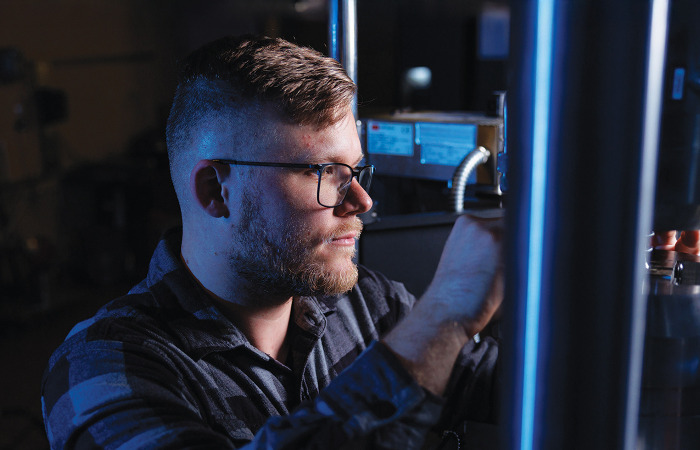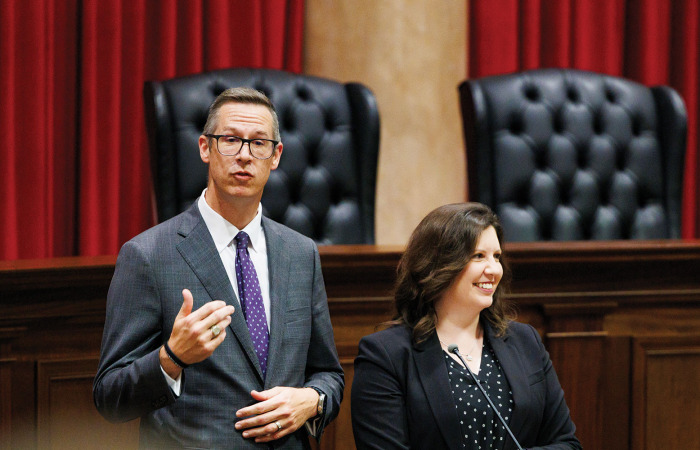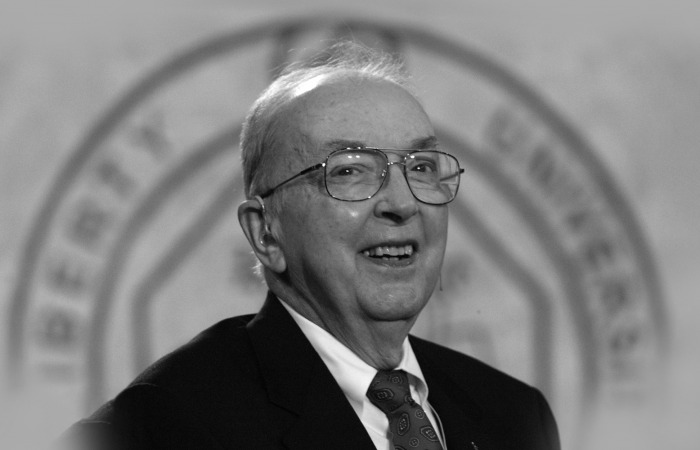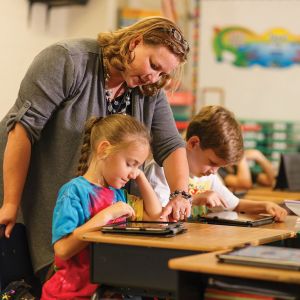
Second-grade teacher and Liberty University alumna Angie Kraje (’00) assists her students as they work on iPads.
It is 9 a.m. at Boonsboro Elementary School in Bedford County, Va. Second-grade teacher and Liberty University alumna Angie Kraje (’00) hands each of her students an iPad and instructs them to open a math application. The students independently complete problems designed for their grade level on their high-tech tool and raise their hands if they have a question.
Tablets and smartboards are common sights in classrooms now. These devices have ushered in a new era of teaching methods. Teachers who once stood in front of a classroom in a cloud of chalk dust and amidst the grinding sound of pencils being sharpened are now using digital tools to engage their students in the learning process.
While some may think this modern trend is a disadvantage — causing too much screen time and not enough hands-on learning — many in education are finding that these cutting-edge tools are helping pupils better prepare to succeed in the 21st century.
Last April, Project Tomorrow — a national educational nonprofit that researches technological resources for K-12 schools — released a report on digital learning, focusing specifically on student experience in a blended classroom, where the teacher integrates technology with traditional teaching methods. The results from over 430,000 K-12 students representing over 8,000 schools in the U.S. showed that 63 percent of teachers use tablets; 58 percent of principals have implemented technology in the classroom; 63 percent of students in grades 6-12 prefer a blended learning environment; and 51 percent of parents want their children in a blended learning environment.
“The ability to use technology within a school or class environment engages students in active learning and establishes a foundation for the development of independent learning,” the report concluded.
With the wave of technology carrying so many school systems into the future, Liberty University’s School of Education is at the forefront, training students to become the future generation of teachers who will employ this new technology and innovation in the most effective ways.
Dr. Karen Parker, dean of the School of Education, said that Liberty is preparing its students for “real-world K-12 settings” by actively training and preparing them to use technology as a valuable tool in their future classrooms. She noted that 90 percent of graduates from Liberty’s program are employed upon graduation.
“To me, this is the highest testament (to our success) — that we are training our teacher candidates to adapt to what is current,” she said. “Educators view our students as the ones bringing new ideas and expertise in using these technologies, which is what we want to maintain.”
Kraje, who earned her B.S. in General Studies with an elementary K-8 teaching licensure, is one of thousands of teachers across America using new technology in their classrooms. She said the courses she took at Liberty prepared her to embrace new experiences and new trends in education.
“To be an educator is also to be a lifelong learner. And with ever-changing technologies, it is necessary to keep current with what’s new,” she said.
School systems nationwide are investing in the latest software and Web apps for all ages, starting in kindergarten, some even assigning tablets and laptops to students for use year-round. Educators everywhere are debating whether or not technology assists with different learning styles, whether it makes school more exciting for the students, and whether or not it is beneficial as a whole.
“There are many ways that technology plays a positive role in student learning,” Kraje said. “Many educational programs have apps and websites designed for hands-on practice, where students have personal logins and applications that are on their level. Many of these programs also provide students’ results immediately so that teachers are able to adapt their instruction to meet the needs of all students.”
Teachers are using creative applications to keep their students excited about their learning. Randall Dunn, associate professor and chair of innovation and technology in the School of Education, recently observed a Liberty student doing his student teaching requirement in a local classroom. The student used a popular Web app that allowed everyone in the room to compete in a trivia game. (These Web apps are becoming popular in restaurants and other public places). He watched as all the students raced to beat each other to the answer.
Parker said technology is effective because it allows students to “individually engage.”
“It appeals to their current interests, and it is meeting them where they are,” she said. “It allows for students to learn actively, and when they are active, they are engaged. When students are using a tablet or laptop in a classroom, they are actively selecting answers.”
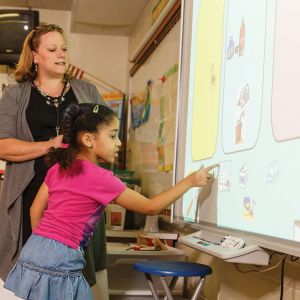
A second-grade student at Boonsboro Elementary School works on a smartboard, a digital projector that allows students to go to the front of the classroom and interact with the entire class while the teacher is presenting the lesson.
Taking the place of whiteboards now are smartboards, a digital projector that allows students to go to the front of the classroom and interact with the entire class while the teacher is presenting the lesson.
Parker said that technology courses are “infused” throughout Liberty’s curriculum. The university has active learning classrooms that are outfitted with these technologies, where students can learn how to integrate the use of smartboards and tablets into their future learning environments.
Dunn teaches courses that focus on using technology in the classroom, and he keeps up-to-date with what the School of Education should implement into its own curriculum.
When Liberty students go to teach in local schools, according to Dunn, they have the opportunity to present new ideas to the teachers.
“In the world of educational research, we usually say five years is the maximum time for something to be current,” he said. “In the world of technology, we say two years because it changes so quickly. We cannot possibly train a sophomore on technology that will be in the classroom when they are finally entering their first year of teaching three years later. We have to train them with the mindset, the approach, and the knowledge in order to be effective using whatever is out there.”
He said one of the newest trends in teaching is not only technology, but also the idea of “flip classrooms” — where the learning environment “flips” from the classroom to the student’s own home. The teacher works to ensure that the content presented to the student that day at school is placed on YouTube, which makes the lesson available to the student at home when they are working on a homework assignment with their parents.
“If your child is learning at home with a parent, then when he or she goes to school the next day, they are able to progress further in the classroom because of the direct instruction that happened at home,” Dunn said.
When students bring their devices home, technology allows parents to be more effective in helping them with homework.
“If a parent does not understand their child’s homework, they can pull up the lesson on the tablet or laptop and learn with their child immediately,” he said.
Liberty utilizes Horizon Reports to stay up-to-date on technology trends. These reports chart emerging technologies for teaching and learning. The 2015 edition showed research indicating that in one to two years, there will be an increased use of flip classrooms and technological devices in the classroom.
“Online learning and classroom learning have now turned into a blended learning environment,” Dunn said. “A long time ago they were separated; however, now they are here to stay, and it is important to keep up with these trends.”
Parker said that technology use in the classroom is an example of “differentiated instruction,” a buzzword in education.
“When we say we ‘differentiate the curriculum,’ we are saying that we are not just teaching a particular subject, but we are learning to adapt our lessons to our students’ needs,” she said.
It feeds into another buzzword: accountability.
“Technology allows for teachers to see how an individual student is participating in an assignment,” she said. “When they use technology in the classroom, teachers are seeing which students are engaged, allowing them to measure a student’s progress immediately. This sets a higher standard not only for the teacher, but also for the student.”
Parker said that technology also helps teachers maintain records.
“Many classrooms are set up to help teachers measure a student’s progress from the beginning of the year, showing where he or she needs to improve,” she said. “Teachers are also responsible for keeping a log of how many students understood what was taught and what they did as an educator to improve understanding. This helps school systems know how effective a teacher is with their students.”
Beth Ackerman, the School of Education’s assistant dean for assessment, said that Liberty’s education students are shown that teaching is a toolbox.
“You have your different tools that you use at different times to make sure your students are learning from all aspects,” she said. “Teaching is not just lecturing, not just group activity, not just essays, and it is not just technology. We teach our students to use every tool in their toolbox in order to speak to 100 percent of their students.”
Ackerman said that “old-school” teaching was giving a student a lesson, then a test, and asking them if they understood a particular subject.
“Now, with the use of technology, educators can assess and constantly engage their students to find out if they understand the material at the beginning of a lesson and if they better understand it by the end of the lesson,” she said. “Technology gives us a tool — a hammer — for constant assessment.”
Parker said that as an educator, it is important to be aware of what is new and how to translate that to your students.
“One great rule in teaching is to not only show a student how to do something, but also to allow them to do it themselves,” she said. “It is important to us that our students learn to walk away from our program knowing there is a method to teaching that engages technology to be effective. Our graduates have that mindset, and they will continue to impress educators for years to come.”
Liberty offers a B.S. in Elementary Education, with specializations in English, math, science, or social science. Students can also add a dual endorsement in special education, which requires them to take two additional courses. A secondary licensure is available for students interested in teaching at the high school level.
Those interested in furthering their degree can earn licensure online through Liberty’s Master of Arts in Teaching (M.A.T.) program. Licensure and non-licensure options are available through the school’s Master of Education (M.Ed.), Education Specialist (Ed.S.), and Doctor of Education (Ed.D.) course offerings.

